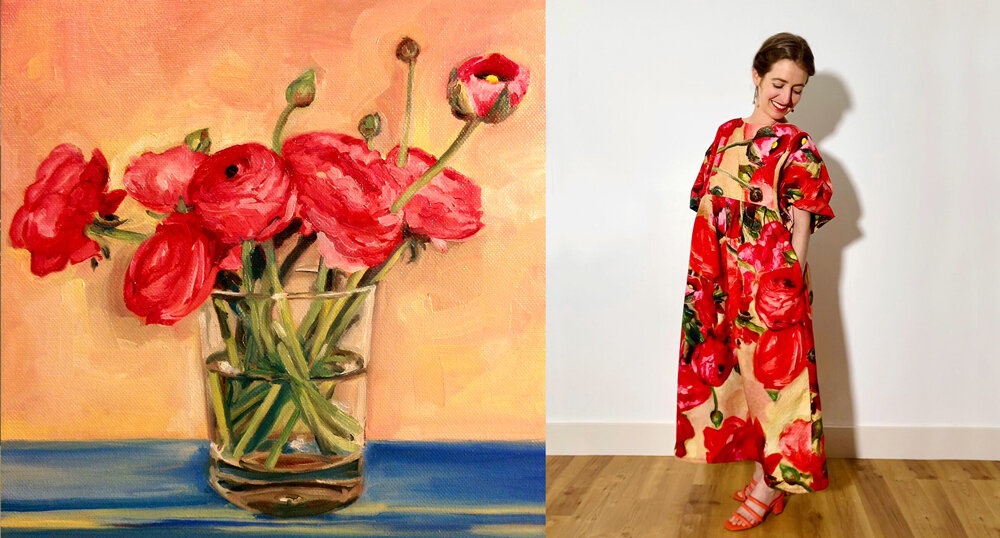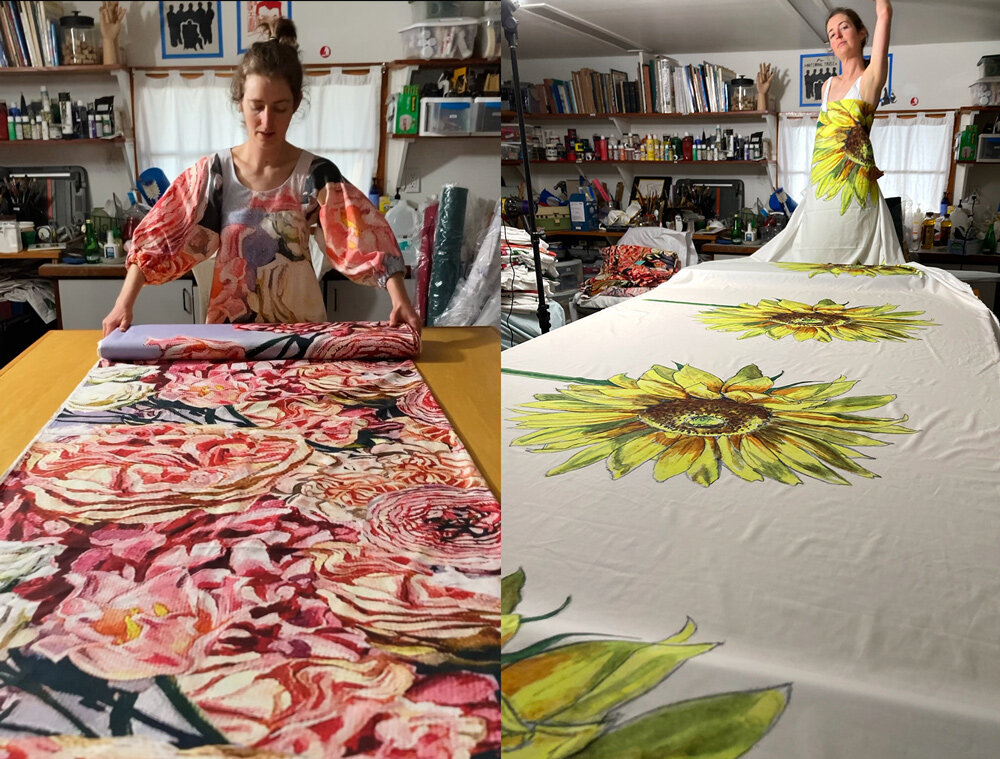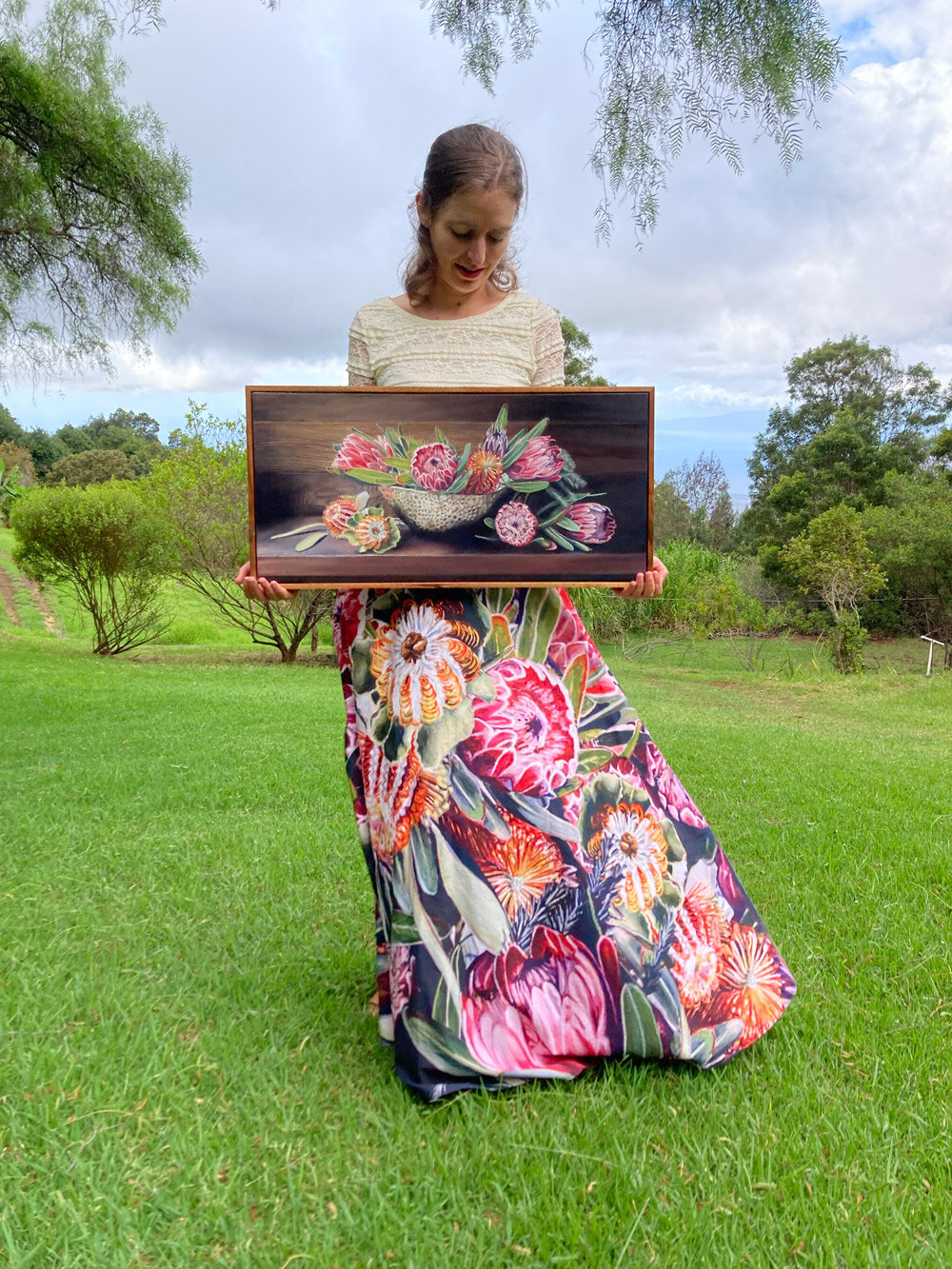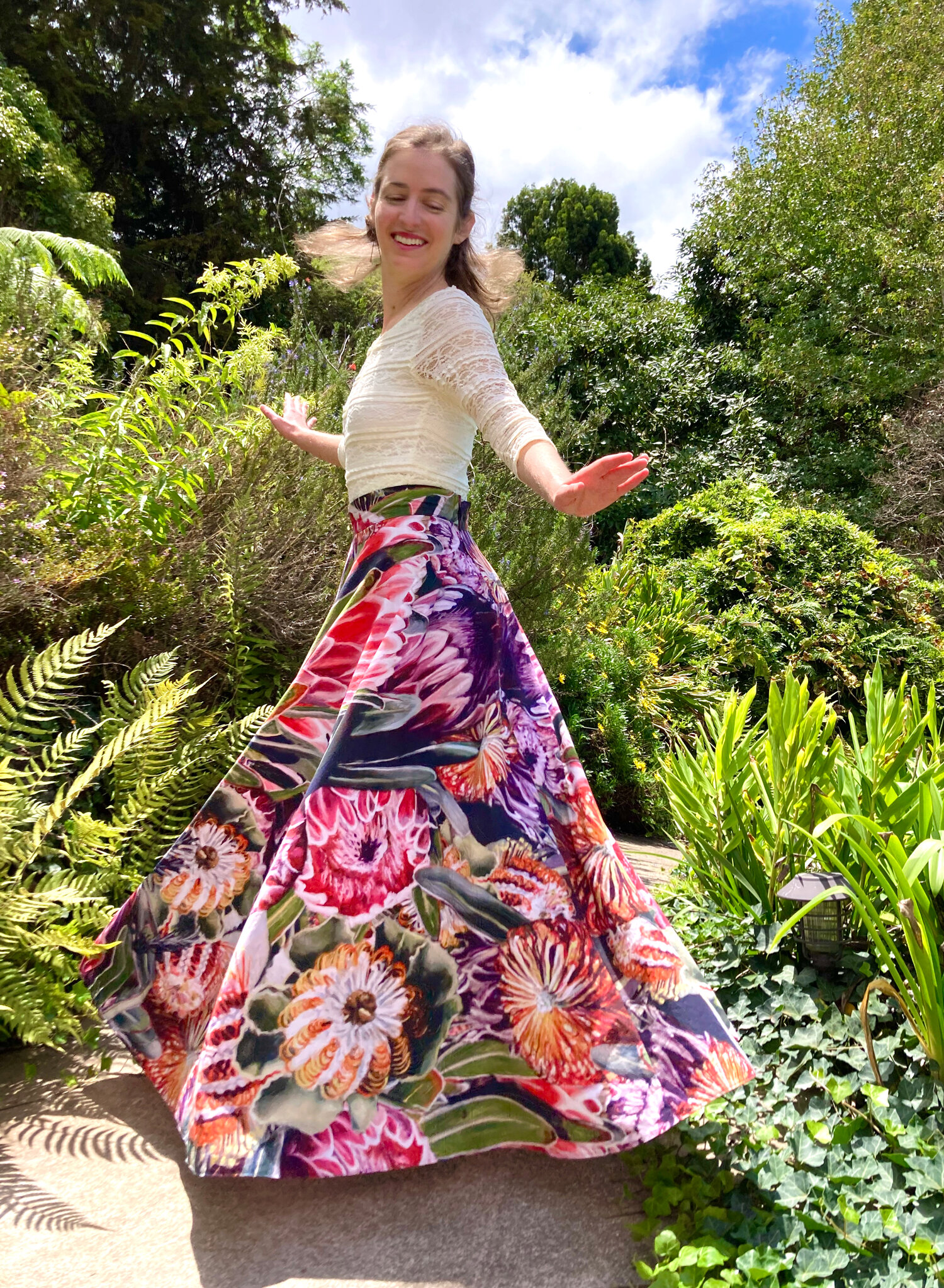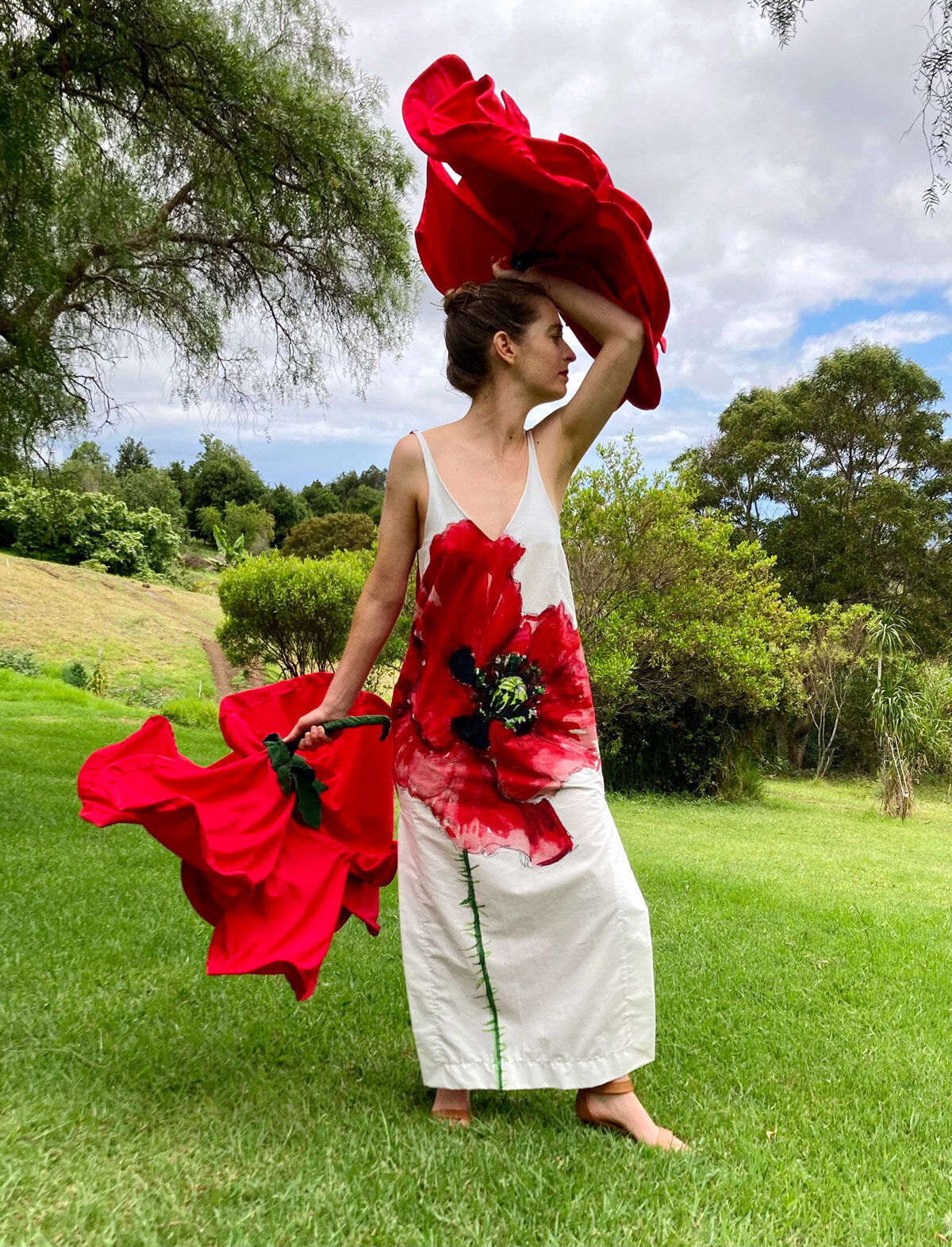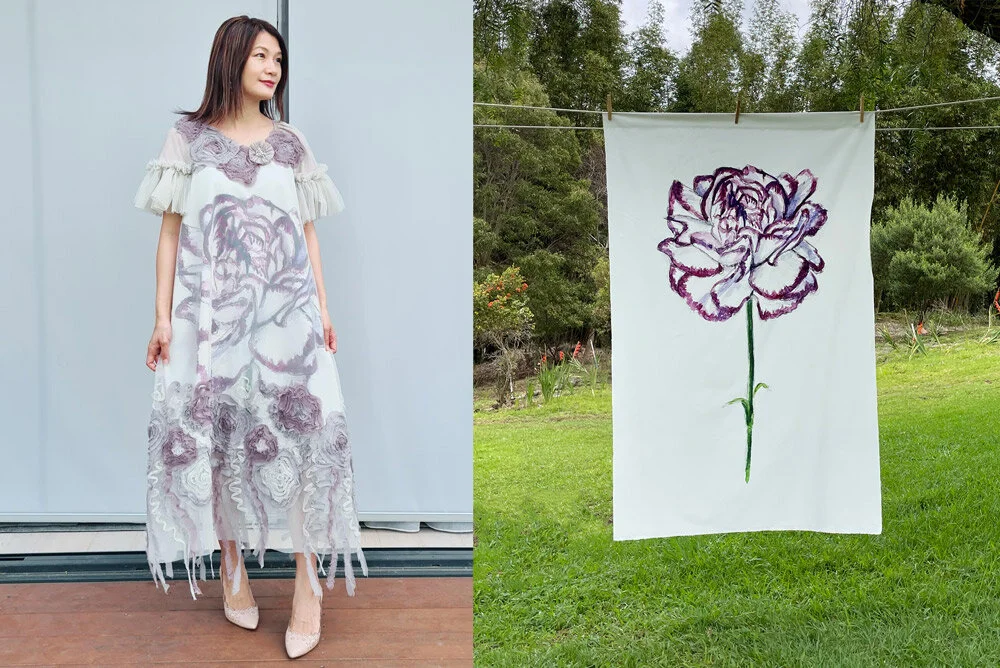Paintings & Textiles: Behind the Scenes
Dressed in Yellow Bouquet Textile featuring my oil painting. I used this photo to announce the release my textile collection in May 2021.
This interview was written in October 2021 as a guest blog for Sewing and the City, a fabulous sewing pattern company. I’ve shared it on my website to give you my back story and a peek into my process.
Q: Tell us about yourself. Who you are and where you are from? How did you find textile design as a passion and what was it that inspired you to become a designer?
A: I am an island kid, born, raised and based on Maui. I am from an unconventional family of artists on both sides. It is hard to talk who I am without telling you about my family and the ways they shaped my path.
In a nutshell, I have become a fusion of the artists on both sides of my family. On my paternal side I’ve been very influenced by my dad and his dad, both professional realist landscape painters. On my maternal side, I’ve been shaped by my mom and her mom, both sewists, fabric designers and fashion designers.
MY DAD + MY GRANDPA:
My late paternal grandfather and my dad both are professional realist landscape painters. In this photo my grandpa James Peter Cost is adding a bridge to my dad Curtis Wilson Cost’s painting, while I sat on my dad’s shoulders. I was immersed in a family of working artists from the start.
My dad, Curtis Wilson Cost, is a realistic landscape painter and has the longest running one-man gallery in the state of Hawai’i, the Curtis Wilson Cost Gallery. He’s been archiving rural Hawai’i as it looked before modern development through his oil paintings since 1973. His father, James Peter Cost, was a professional realist landscape painter capturing rural California and had his own long standing gallery in Carmel.
I don’t remember my dad teaching me to paint, but he taught me in ways more powerful than holding brushes. I remember being little and hanging out with him in a hammock suspended through our 40 foot avocado trees at sunset. He would point at clouds and shadows and tell me which paints you would mix to get those exact hues. I spent a lot of my early life wandering around in my dad’s studio absorbing him painting through osmosis. We did not have a TV, so for fun my brother and I ran around in the forest all day or did art projects. On family trips we often visited museums and art galleries and my dad brought my attention to many details in paintings by John Singer Sargent, the Wyeth family and other greats. My childhood was filled with drawing and painting, which became the basic building blocks of what I do now. As a teenager, my dad dropped me off at the home of his amazing artist friend Kit Gentry where I painted in the living room and received frequent critiques that really transformed my work. I ended up getting a BA in studio art in college. In my early twenties, I got to take a color theory class with my dad’s good friend Dick Nelson who spent his career studying color under Joseph Albers. After college, my dad, brother, and I went to a couple painting intensives taught by the great painters Casey Baugh and Douglas Flynt. My dad loved to learn and gave me the gift of exposing me to artists he admired.
MY MOM + MY GRANDMA:
Left: My mom, Jill Radner Cost, in 1976 running a booth on Maui of her handmade wares for her one-woman business, Kulia Batiks. She created all her own designs, batiked them onto fabrics, and then quilted and sewed them into garments, bags, and home goods.
Right: This photo of my late grandmother, Rogene Radner, working as a textile designer, was featured in National Geographic’s “Hawaii” published in 1970. The caption in National Geographic reads: “At Malia Hawaii, Inc, Rogene Radner paints bright patterns for holiday wear.”
My mom’s mother, Rogene Radner, was a professional painter, illustrator, fashion designer, and textile designer. She designed fabrics for Malia, Hawaii, Inc and also had her own fashion line on O’ahu in the 1970s called “Rogene of Hawaii.” I still have swatches of the delightful fabrics she designed, which were used for concierges and hotel staff uniforms on Maui. There’s even one with tiny ink drawings of tennis players and tennis courts she created for the Royal Lahaina Resort. Her textiles enchanted me as a child and still do. When I was about 9, my grandparents moved from Maui to San Francisco as they entered their retirement years, so most of my life I connected with my grandma from afar. She was a wonderful penpal and she sent me pages of her own beautifully hand drawn paper dolls and outfits. My mom would make photocopies of them and let me mess around with those. I think that my hours doodling designs on my grandma’s drawings of clothing planted early seedlings for my textile design work. I had seen the above National Geographic picture as a kid but did not know much about her career until I was an adult. It amazes me how much I have followed in her footsteps without knowing it.
Before I was born and my dad’s painting career took off, my mom, Jill Radner Cost, ran her own one-woman batik and sewing business called Kulia Batiks. Throughout my childhood there were remnants of her beautiful batiks and binders of her designs around the house. She brought sewing into our lives from the start. I was so young that I can’t remember learning to sew, but I recall watching my toddler brother learning on her old black Singer machine that came out of a dusty hard case. My mom self-drafted and sewed all of our clothes until I was around 8 and my brother was 3. The love my mom showed me through sewing flows into my relationships with my fabric clients now. The fact that people love my fabrics enough to sew incredible garments with them absolutely overwhelms me. I am honored to see my art becoming handmade clothes that will hopefully be treasured and passed down.
I sewed passionately as a kid and teenager but I was very improvisational and had loose technical knowledge. After graduate school, when I lived in Berkeley, California from 2011-2017, I found a free sewing machine on the street and excitedly started making up my own patterns to sew clothes for a little girl I nannied named Maddy. Later that year, my dear friend Lillian Kang (Maddy’s mom) gave me a proper sewing class with the fabulous teacher, Mary Patrone, at Stone Mountain and Daughter Fabrics. Learning to follow patterns and make professional looking clothes led me a step closer to my current path as a textile designer. Stone Mountain was just a few blocks from my house. In retrospect, I can’t believe how fateful it was that it is one of the most sought after stores for artful fabric! I made a habit of just wandering through the store looking at all the textile designs. Discovering the gorgeous fabrics of Nani Iro really affected me. I bought a few precious yards and would tell anyone who came to my house to look at the fabric and notice the paint strokes and pencil lines. I would exclaim to my friends: “That’s a real painting!” and they would look a little confused at my fervor. The fact that I was so infatuated with the artifacts of a painting in fabric should have been an indication of a direction I would be heading, but I couldn’t see it just yet. In the Bay Area, I was occupied up to my eyebrows freelancing full time as a painter.
A photo of me from a San Francisco Chronicle article about my paintings in 2014. Photo taken by SF Chronicle photographer Scott Strazzante.
The real turn towards textile design happened in 2019. By that time, I was absolutely smitten with sewing my own wardrobe and really wanted to have my own art on fabric, but the idea was vague. I had been mulling it over, talking to friends about block printing and screen printing, and asking for tips and ideas. I tried block printing several times and wasn’t satisfied. Carving is not my great skill, nor interest, and it couldn’t produce the level of rendering I had been practicing in depth in my career for over a decade in my oil paintings and watercolors. I wanted my realistic paintings on fabric. In August 2019, I visited NYC and was hanging out with my college friend, Lucy Vasserman, who had supported my art career for many years. Earlier that year, I had bullied her into learning to sew, which she loved, and now it was her turn to do the bullying. She urged me to digitally print my artwork onto fabric. It hit me on the head that this is exactly what I needed to do. I flew home to Maui and promptly launched a series of watercolor paintings of flowers. Two years later, these flowers have become my #giantflowertextile collection, and the paintings appear in many other textile designs as well.
I’ve been working since August 2019 to create a whole array of textile designs based on my oil and watercolor paintings. In May 2021, I officially launched my textile business to the public via my Instagram @juliaallissoncost. So at the time of writing this, it has been only 5 months of sending my fabric to clients all around the world, but somehow it feels like forever! It has taken all my life’s work to get to this chapter.
I am wearing a skirt of Yellow Bouquet Textile and Blush Watercolor Textile is on the clothesline. My oil painting of a dancer’s skirt is on the easel. Photo by Yasmine Lindskog
Q: Can you tell us a little about your design process?
A: It all starts with paintings. Having painted professionally since 2005, I have quite a large body of work to gradually transform into textiles. Some of my first textile designs were based on a series of floral oil paintings I did in 2017. I had asked the talented florist, Jin at Flora Arte in Berkeley, to create bouquets for me to paint throughout the summer, each featuring a different color scheme. So far, I have made 3 of those bouquet paintings into fabrics and folks across the world are sewing and wearing Pink Bouquet Jubilee and Pink Bouquet and Lilac designs (2 variations based on my original Pink Bouquet painting) and Yellow Bouquet Textile and Blue Bouquet Textile. Other recent designs include Ranunculus Bouquet Textile, which features my 2015 oil painting of a cup of ranunculus, and Succulent Garden Textile, featuring my 2017 oil painting of a rainbow-hued garden of house plants and pottery.
My Pink Bouquet oil painting (2017), which became Pink Bouquet Jubilee and Pink Bouquet and Lilac textiles in 2021.
My Blue Bouquet oil painting (2017), which became Blue Bouquet Textile in 2021.
My Ranunculus Bouquet oil painting (2015), which became Ranunculus Bouquet Textile in 2021.
My Succulent Garden oil painting (2017), which became Succulent Garden Textile in 2021.
Q: Tell us about your workspace.
A: Since 1985, my family has lived in a house my parents built on 5 acres of forested pastural land on Haleakalā. The road is dotted with small farms including a pig farm and a goat pasture that runs along one side of our property. There’s a forest of native Hawaiian trees below us leading out to a view of the West Maui Mountains, and a 30 foot gulch on the other side of the property that turns into a wild river of waterfalls in a big storm. My dad has spent decades gradually designing pathways, bridges, and trellises all around the yard, and the garden is a bit of a jungle, so the whole place is rather like Swiss Family Robinson.
There’s an art studio across the deck from the main house, which is where my dad still paints today. I moved back to Maui in 2017 and now share the painting studio with him. His easel is on the south wall and mine is on the north wall. Stretcher bars are dangling above us from the rafters. As I write this, I have an array of my oil painting illustrations for my first children’s book spread across the wall next to my easel. Canvases and frames are leaning against taborets piled with jars of brushes and thinners. Sometimes my dad and I listen to the same audiobooks together. There’s a big double door on the west wall of the studio that opens onto the deck that looks down the mountainside. The breeze wafts through the open studio. At the end of a long painting day, one of us reminds the other to go check out the sunset colors over the ocean.
Left: My easel in the art studio. Center: A glimpse of painting on the deck, photo taken by my friend Nancy Chen of @iusedtobeacurtain. Right: A glimpse into our family art gallery, the Curtis Wilson Cost Gallery, where clients can visit by appointment.
We had a garage at one point, but when I was a kid, my mom announced that we were turning it into a “project room,” and to this day, it is basically an art supply store with a huge table in the middle and almost everything you could need organized and labeled on shelves piled to the ceiling. The project room is now where my fabric inventory is stored on shelves, and I use the big table for bolting, cutting, folding, and wrapping orders. There’s a dutch door and I love leaving it open to smell the fresh air from the garden.
Bolting (and playing dress up) with fabrics in the project room. Left: Pink Bouquet and Lilac. Right: Giant Sunflower Panels.
I design my textiles at the kitchen island and photograph the fabrics and garments in the gardens around the house. So the whole property is my work space. Living in so much beauty certainly inspires my work. I am so grateful for my home.
Hanging and wearing Pink Bouquet Jubilee textile. My dress is made with cotton poplin and the Pattern Fantastique Vali Dress pattern.
Q: Which is your favorite fabric you have created?
A: I love them all for different reasons and each sewist who works with them brings out their own personalities in my fabrics, making me fall in love all over again. It is quite amazing to witness.
I do have an especially tender spot for each new fabric design as I release it, so right now I’m very excited about my Protea Bouquet Textile. It is the first oil painting I’ve done knowing that I would transform it into a textile. I wanted it to be epic and it did not disappoint me.
My newest original oil painting “Bowl of Paradise” (2021) and the textile based on it: Protea Bouquet Textile. Here I’m holding the painting one last time before shipping it off to the collector who acquired it.
Protea Bouquet Textile cotton poplin sewn into a half circle skirt using this tutorial by Marcy Harriell.
The Protea Bouquet Textile has a wild origin story that began when two painting clients separately asked me if I had ever considered making protea fabric. One client had lived on Maui as a child, where protea are farmed all over the upcountry area, the other client is from South Africa where king protea are the national flower. I took this as a sign and asked my friend Katie, who has some great king protea bushes, if I could get some stems from her. Over the next few months, I painted an oil on canvas still life, “Kula Kings”, (which found its home with a collector in Canada) and also individual watercolors of each stem to create a textile with it: Protea Watercolor Textile. I sewed up an aloha shirt with this fabric for my dad, and posted a photo of it on my Instagram using a bunch of hashtags about protea, king protea, Maui protea, etc. Because of these hashtags, the local protea farmer, Kainoa Aluli of Island Protea Maui, found my photo and within a few messages, we realized his farm is just up the road from me! I asked if I could paint his flowers and he invited me to come and walk the farm the next day. He kindly sent me home with a handful of stems and I painted them in oil on canvas in a hammered gold bowl during the first half of 2021. That original painting “Bowl of Paradise” found its home with a collector on the mainland and then I designed the Protea Bouquet Textile, which is now heading all over the world. The process of allowing one idea to lead to the next has been marvelous, introducing me to amazing people and creating so many avenues of art making. I can’t wait to see what people will sew with this fabric.
My neighbor Kainoa Aluli, the protea farmer of Island Protea Maui wearing a Protea Watercolor Textile aloha shirt and standing with a bunch of his blooms. He grew the flowers featured in my “Bowl of Paradise” oil painting and the Protea Bouquet Textile.
Q: What’s the latest sewing project you’ve completed? And what are you working on at the moment?
A: I just finished the Sewing and the City Wooster Jacket using my Protea 1 and Protea 2 giant flower panels, lined with Protea Watercolor Textile cotton double gauze. I hacked the jacket to make it lined, reversible, and longer, plus I added pleated cuffs. The outside is hand stitched with sashiko thread accentuating the protea painting. Next I’ll be sewing samples with new textiles I’ll be releasing in early 2022.
Q: When you are experiencing a creative block, what do you do to get back into the spirit?
A: I always have many projects going at the same time. While it can sometimes make me feel a bit mad, it is also a helpful work flow strategy. When I am exhausted by one part of my work, I move to another project and the shift gives me fresh perspective.
Another strategy I use to maintain energy is taking a full day off from technology once per week. It is a radical state changer and refreshes me. My mind starts wandering more playfully and improvisationally. I have been doing a weekly tech-free day for over year now, and most of my best ideas came to me on those days. I think everyone could benefit from it!
Lastly, I love returning to the foundation of my work: drawing. Sitting anywhere with a notebook and capturing the world around me makes me hyper attentive and fills me with gratitude and wonder about every little thing. I especially love doing this when I travel, but during the pandemic, I have been drawing lots of areas around the house and it is a centering, joyful practice.
A peek into my sketchbook. Left: A dress I sewed and embroidered, along with a mural I painted on my wall. Right: My kitchen shelf.
Q: What’s the best tip for sewing with your prints?
A: My clients all have different imaginative ideas for how to use my fabrics and everyone’s pieces have their own personalities. To start, I’d suggest browsing through my Instagram and my fabric boutique as I feature my clients’ creations. Their projects might spark your own. Other ideas below:
1) LEAVE IT WHOLE:
Pick a simple pattern that allows for a big unbroken canvas. You’ll have a garment with a painting sweeping across it.
Dress is made with a Giant Poppy panel and plain red cotton poplin on the back using the Pattern Fantastique Teia Dress Pattern.
2) BREAK IT UP
Break up the design and feature parts of it on different windows of a garment. Below Nancy Chen of @iusedtobeacurtain made my Giant Tuberose panel run down one arm and combined it with a grey bodice that matches the pencil lines in the watercolor.
Shirt is made with a Giant Tuberose panel and plain grey cotton poplin in the bodice using the Pattern Fantastique Celestial Dress Pattern.
3) BUILD AROUND THE PAINTING
In my boutique you’ll find cotton poplin quilting squares featuring a bunch of my paintings and sketches. These can be storytelling centerpieces in a garment. Below is a dress featuring my oil painting, “Maddy and the Red Ballon,” on the back bodice, as well as scraps of my other textiles mixed with plains, stripes and vintage prints.
I created this dress in a collaboration with Charlotte Stone Shoes. Read their feature about my dress here. I used the Pattern Fantastique Vali Dress pattern.
4) COLLAGE
Cut and piece together my fabrics to make your own collage, drawing the focus to the colors and textures of the brushstrokes.
5) LAYER AND EMBELLISH
Gather other fabrics to embellish the painting. My client, Silvia Liu of @mauve.cloud.studio, layered tulle and 3D flowers over a Giant Carnation panel and made something worthy of a runway.
Silvia Liu of @mauve.cloud.studio sewed this dress with a Giant Carnation panel and the Pattern Fantastique Calyx Smock Pattern, layering tulle over the panel to mute it to the same tone as the 3D flowers she added to her dress.
6) WHOLE CLOTH QUILTING
My fabrics work great for whole cloth quilting, allowing an entire painting to cover a bedspread. Here are both sides of a quilt made with 2 of my fabrics, quilted by Harriet Alms of @halii_by_harriet.
Left: Pink Bouquet and Lilac, Right: Giant Dahlia panel size XL
The sky is the limit and I cannot wait to see what ideas you will have!
Browse my fabric boutique here. Inquire about painting commissions via julia@costgallery.com








